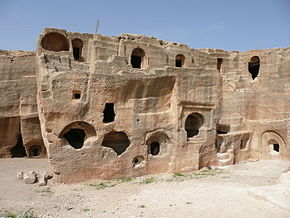Dara (Mesopotamia)
| Δάρας (Greek) | |

Ruins of rock-cut building in Daras
|
|
| Alternate name | Daras, Anastasiopolis, Iustiniana Nova |
|---|---|
| Location | Oğuz, Mardin Province, Turkey |
| Region | Mesopotamia |
| Coordinates | 37°10′40″N 40°56′28″E / 37.17778°N 40.94111°ECoordinates: 37°10′40″N 40°56′28″E / 37.17778°N 40.94111°E |
| Type | Settlement |
| History | |
| Builder | Anastasius I |
| Founded | 505 |
| Abandoned | After 639 |
| Periods | Late Antiquity |
| Events | Battle of Dara |
Dara or Daras (Greek: Δάρας) was an important East Roman fortress city in northern Mesopotamia on the border with the Sassanid Empire. Because of its great strategic importance, it featured prominently in the Roman-Persian conflicts of the 6th century, with the famous Battle of Dara taking place before its walls in 530. The former (arch)bishopric remains a multiple Catholic titular see. Today the Turkish village of Oğuz, Mardin Province, occupies its location.
During the Anastasian War in 502–506, the Roman armies fared badly against the Sassanid Persians. According to the Syriac Chronicle of Zacharias of Mytilene, the Roman generals blamed their difficulties on the lack of a strong base in the area, as opposed to the Persians, who held the great city of Nisibis (which until its cession in 363 had served the same purpose for the Romans).
Therefore, in 505, while the Persian King Kavadh I was distracted in the East, Emperor Anastasius I decided to rebuild the village of Dara, only 18 kilometres westwards from Nisibis and just 5 km from the actual border with Persia, to be "a refuge for the army in which they might rest, and for the preparation of weapons, and to guard the country of the Arabs from the inroads of the Persians and Saracens". Masons and workers from all over Mesopotamia were gathered and worked with great haste. The new city was built on three hills, on the highest of which stood the citadel, and endowed with great storehouses, a public bath and water cisterns. It took the name Anastasiopolis (Greek: Ἀναστασιούπολις) and became the seat of the Roman dux Mesopotamiae.
...
Wikipedia

